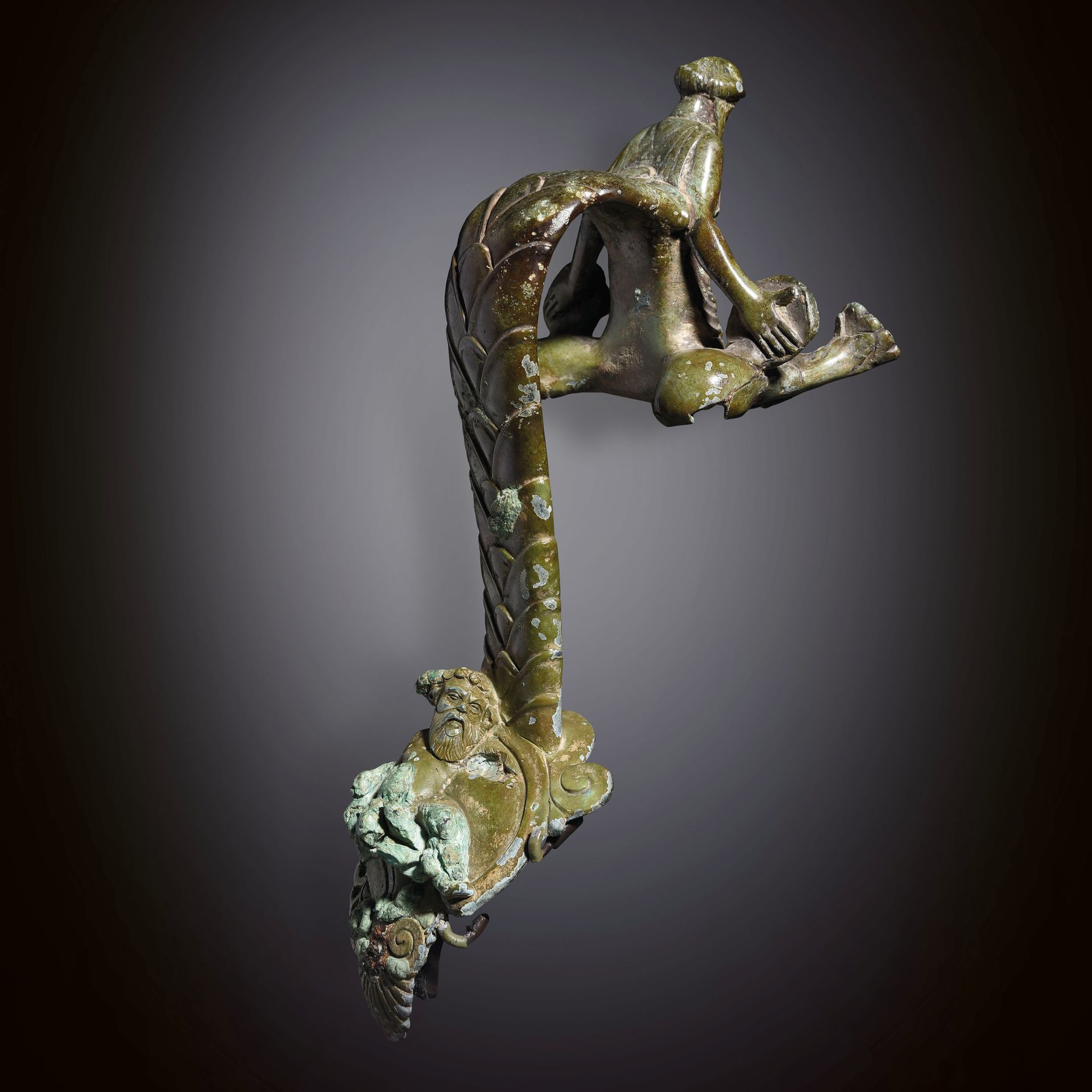Description
EXCEPTIONAL OINOCHOE HANDLE WITH PAPPOSILENE Greece, Attic art, 470-450 B.C. Bronze with uniform green patina In places, strong oxidation Traces of iron on the palmette Dim. 20 x 7,6 cm Provenance Former European private collection acquired by the current owner in 1999 Bibliography FRONTISI-DUCROUX F., - LISSARAGUE F., From ambiguity to ambivalence, a Dionysian journey, in Annali dell'Instituto orientale di Napoli (AION) 5, 1983, pp. 11-32 This handle, composed of different elements melted with lost wax and welded, belonged to a Schnabelkanne type oenochoe. The decoration is particularly elaborate - the inner attachment of the handle has a medallion with a papposilene, palmettes and scrolls while the outer face of the handle is decorated with lotus buds (?). A male torso dressed in a female peplos holds two masks of Medusa (?). The singularity of this iconographic repertoire is partly rooted in Dionysian symbolism, notably with the presence of this papposilene, but remains very original with the presence of this ambiguous weighting. In the plastic arts, no comparable statuette can be mentioned. Nevertheless, the Attic ceramics of the first half of the 5th century B.C. provides a series of images of Dionysian processions where bearded men appear dressed as women and/or where bearded men appear dressed as women and/or provided with female attributes. It could be the poet Anacreon (Sappho's companion), men dressed according to a new oriental (Lydian) fashion or - according to the most recent interpretation - the only way that men could adopt to participate in the Dionysian processions (in the Attic iconography, Dionysus is accompanied by satyrs, maenads or women, but very rarely by men) A greek attic bronze oinochoe handle with drunken Silenus. This handle made up of different elements melted with lost wax and welded, belonged to a Schnabelkanne type oenochoe. The decoration is particularly elaborate - the interior attachment of the handle features a medallion with a papposilene, palmettes and volutes, while the exterior face of the handle is adorned with lotus buds (?). A male torso dressed as a female peplos holds two Medusa masks (?). The singularity of this iconographic repertoire finds its roots in part in the Dionysian symbolism, in particular with the presence of this papposilene, but remains very original by the presence of this ambiguous character. In the plastic arts, no comparable statuette of can be mentioned. Nevertheless, Attic pottery from the first half of the 5th century. BC provides a series of images of Dionysian processions where bearded men appear dressed as women and / where bearded men appear dressed as women and / or with feminine attributes. It could be the poet Anacreon (Sappho's companion), men dressed in a new oriental fashion (Lydian) or - depending on the most recent interpretation - the only way men could adopt to participate in processions. Dionysiacs (in Attic iconography, Dionysus is accompanied by satyrs, maenads or women, but very rarely by men). Ca. 470-450 B.C.
89
EXCEPTIONAL OINOCHOE HANDLE WITH PAPPOSILENE Greece, Attic art, 470-450 B.C. Bronze with uniform green patina In places, strong oxidation Traces of iron on the palmette Dim. 20 x 7,6 cm Provenance Former European private collection acquired by the current owner in 1999 Bibliography FRONTISI-DUCROUX F., - LISSARAGUE F., From ambiguity to ambivalence, a Dionysian journey, in Annali dell'Instituto orientale di Napoli (AION) 5, 1983, pp. 11-32 This handle, composed of different elements melted with lost wax and welded, belonged to a Schnabelkanne type oenochoe. The decoration is particularly elaborate - the inner attachment of the handle has a medallion with a papposilene, palmettes and scrolls while the outer face of the handle is decorated with lotus buds (?). A male torso dressed in a female peplos holds two masks of Medusa (?). The singularity of this iconographic repertoire is partly rooted in Dionysian symbolism, notably with the presence of this papposilene, but remains very original with the presence of this ambiguous weighting. In the plastic arts, no comparable statuette can be mentioned. Nevertheless, the Attic ceramics of the first half of the 5th century B.C. provides a series of images of Dionysian processions where bearded men appear dressed as women and/or where bearded men appear dressed as women and/or provided with female attributes. It could be the poet Anacreon (Sappho's companion), men dressed according to a new oriental (Lydian) fashion or - according to the most recent interpretation - the only way that men could adopt to participate in the Dionysian processions (in the Attic iconography, Dionysus is accompanied by satyrs, maenads or women, but very rarely by men) A greek attic bronze oinochoe handle with drunken Silenus. This handle made up of different elements melted with lost wax and welded, belonged to a Schnabelkanne type oenochoe. The decoration is particularly elaborate - the interior attachment of the handle features a medallion with a papposilene, palmettes and volutes, while the exterior face of the handle is adorned with lotus buds (?). A male torso dressed as a female peplos holds two Medusa masks (?). The singularity of this iconographic repertoire finds its roots in part in the Dionysian symbolism, in particular with the presence of this papposilene, but remains very original by the presence of this ambiguous character. In the plastic arts, no comparable statuette of can be mentioned. Nevertheless, Attic pottery from the first half of the 5th century. BC provides a series of images of Dionysian processions where bearded men appear dressed as women and / where bearded men appear dressed as women and / or with feminine attributes. It could be the poet Anacreon (Sappho's companion), men dressed in a new oriental fashion (Lydian) or - depending on the most recent interpretation - the only way men could adopt to participate in processions. Dionysiacs (in Attic iconography, Dionysus is accompanied by satyrs, maenads or women, but very rarely by men). Ca. 470-450 B.C.
